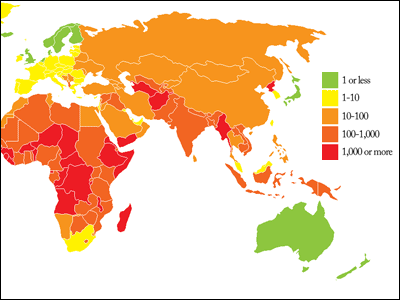The IPv4 address assigned to Europe is finally exhausted

Bythierry ehrmann
An IP address indispensable for doing the Internet. The most popular IPv4 address is represented by 32 bits and it is possible to create about 4.3 billion addresses, but in fact the problem of exhaustion of this IPv4 address in Europe is happening. Distribute IP addresses to Europe, Middle East, Central Asia regionRIPE NCCaccording to,IANAIt ran out of the last IP address allocated from.
RIPE NCC IPv4 Available Pool - Graph - RIPE Network Coordination Center
https://www.ripe.net/publications/ipv6-info-centre/about-ipv6/ipv4-exhaustion/ipv4-available-pool-graph
OK, this time it's for real: The last available IPv4 address block has gone • The Register
https://www.theregister.co.uk/2018/04/18/llast_ipv4_address
IPv4 address is managed by IANA in a comprehensive manner, and its IPv4 address was distributed through address management organizations such as Asia, Europe, North America region. However, the IPv4 address managed by IANA in February 2011 is exhausted, and the address is distributed to East Asia, South Asia and the Pacific area later in the same yearAPNICUnassigned IP address no longer exists in. Subsequently, in September 2012, the unassigned IP address of RIPE NCC is exhausted. Later, in Latin America and the Caribbean coastal area will be managed in June 2014LACNIC,furtherIn September 2015, the IPv4 address of ARIN which manages North America region, IPv4 addresses have been exhausted one after another by address management organizations all over the world.
Even after depletion of IPv4 address, each organization has responded by using the unused IP address, but in RIPE NCC, the last IPv4 address (185.0.) Received from IANA on the week of April 7, 2018, 0.0 / 8) has finally been exhausted. The graph below shows the transition of IP addresses that can be allocated by RIPE NCC, and the transition of the IP address (185.0.0.0 / 8) allocated from IANA at the end is shown in a dark green graph.

After depletion of addresses, redistribution of IPv4 addresses that are no longer used (the green part of the graph above) will be actively performed. However, from the tendency of the above graph, it is expected that there will be no IPv4 addresses available around the year 2020.
As a means to avoid IPv4 address exhaustion problems, migration to IPv6 address has been urged before. Since the IPv6 address is represented by 128 bits, it is possible to use a huge number of addresses of about 340 queues, which effectively solves the exhaustion problem.
As of 2018, about 26.3% of the top 1000 websites accessing the world is moving to IPv6, and steadily spreading waves are progressing. If you proceed at this pace, it is estimated that all major websites will be migrated to IPv6 in May 2021.
Related Posts:
in Software, Web Service, Posted by darkhorse_log







